The Collins farm, Crumlin, Co.Dublin
The
Patrick Collins farm
at
Crumlin, Co.Dublin.
The Collins house was in Crumlin townland,
Crumlin par,
Uppercross Barony,
Co.Dublin.

Crumlin in 1795,
by Francis Jukes.
CRUMLIN in
[Ball, vol.4, 1906]
says this is from 1795.
See their
black and white copy
on
p.135.
Picture was published in London 1799.
Image above from
alamy.com.
This is a view from the SW side of the village.
The church is the CoI church (Old St Mary's Church).
The houses to the right of it are the houses along the main street of Crumlin.
Some of the land in the foreground and to the left may be Collins land.
Though Collins might not be there yet.
Crumlin had a medieval cross, apparently at
the junction of (what is now) St.Mary's Road and Crumlin Road.
[Watchorn, 2024, pp.38-41] and earlier
[Watchorn, 1985, pp.12-13]
discuss the cross.
At some point it vanished, maybe in the 17th century.
But up to modern times,
funeral processions would still start at this location,
apparently
because it was the site of the old cross.
In any case, this location became called "Crumlin Cross".
When Patrick Collins' wife died in 1877, her address is given as "Crumlin Cross".
When Patrick Collins died in 1880, his address is given as "Crumlin Cross".
When Christopher Collins
died in 1884, his address is given as "Cross-roads, Crumlin".
Thomas Collins
died in 1889 at
"Crumlin Cross Roads".
All the evidence (below) is that the Collins house was beside this junction.
In 2002 a new cross was erected at the junction
by Crumlin Historical Society to mark the apparent site of the medieval village cross.

Extract from
p.697 of
The history of the county of Dublin,
by John D'Alton, 1838.
This says that a document of 1496 suggests a cross then stood in Crumlin. But does not name or reference the document.
This 1838 book is the source for the 1496 note in the 1921 book below.

Extract from
p.195 of
The Neighbourhood of Dublin
(1921 edn) by Weston St. John Joyce.
Discussing the likely location of the cross at
the triangular plot at the end of the Collins property,
at the cross-roads.
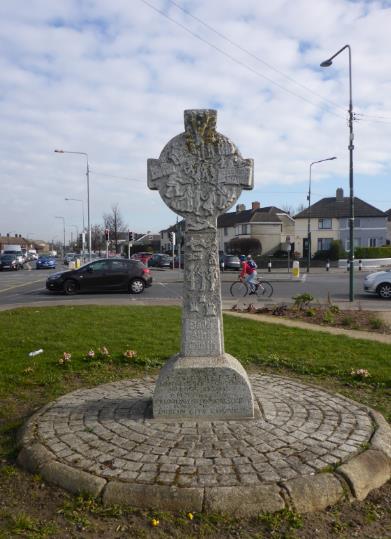
The new cross erected in 2002.
From
pp.56-57 of
Appendix A15.1
of
Tallaght/Clondalkin to City Centre Core Bus Corridor Scheme (2023).

"Crumlin Cross".
The new cross today at the junction of
St.Mary's Road and Crumlin Road.
From street view.
Patrick Collins (apparently bapt 1812)
was a farmer and market gardener at Crumlin.
It is unclear if
his family
is from Crumlin,
or if Patrick is the first one in Crumlin.
There is no section for
Crumlin in
[Pettigrew & Oulton, 1835].
Patrick Collins is
listed
at Crumlin in
[Pettigrew & Oulton, 1836, p.300].
He is
listed
at Crumlin in
[Pettigrew & Oulton, 1837, p.673].
He
is listed
at "Crumlin Road", Crumlin, in
[Pettigrew & Oulton]
1838 to 1843
and
[Thom's] 1850 to 1877.
See him
listed
on Crumlin Road, Crumlin, in
[Thom's, 1850, p.840].
See him
listed on
Crumlin road, Crumlin, in
[Thom's, 1852, p.911].
See him
listed on
Crumlin road, Crumlin, in
[Thom's, 1858].
See him
listed on
Crumlin road, Crumlin, in
[Thom's, 1868].
See him
listed on
Crumlin road, Crumlin, in
[Thom's, 1877].
He died 1880.
His son
Christopher Collins
is listed
at "Crumlin Road", Crumlin, in
[Thom's] 1882 to 1884.
Christopher died at "Cross-roads, Crumlin" in 1884.
Christopher's brother
Thomas Collins
died in 1889 at
"Crumlin Cross Roads".

Crumlin on
Taylor's map of 1816.
Seems to be a lot of activity on what later became the Patrick Collins property.
Also shows a 4-way cross-roads here. One of these roads was soon removed,
so it became a 3-way junction.
Note "Commons of Crumlin" and "Commons" both to the SW side of the main street.
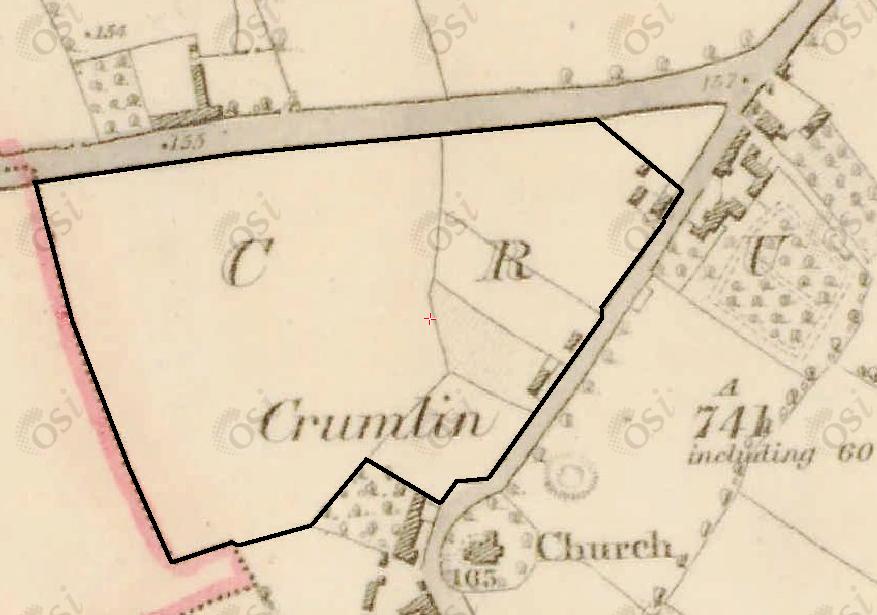
The central part of the Patrick Collins property
in Crumlin on
1829 to 1842 map.
We mark the Collins property as known in 1850 (see below).
This is the N and W side of what is now called St.Mary's Road.
There was a medieval cross at the cross-roads here.
The house near the cross-roads would be the Collins house (see evidence below).
Later (post-1850) Patrick Collins also held the land to the left of this, in Walkinstown townland.
See the Shaw map of 1879.
See original.

Patrick Collins
listed
at Crumlin in
[Pettigrew & Oulton, 1836, p.300].




Part of entry for Crumlin townland, Crumlin par,
in
[Griffiths Valuation, 1847].
See full size
p.1 and
p.2.
Patrick Collins clearly lives at plot 24 (a decent size house with 13 acres).
According to the
guide,
he lives at the main farmhouse ("a") in plot 24,
and there are three smaller houses (b,c,d) in plot 24.
Collins is:
- renting a plot of 3 acres with no house (plot 6)
- sub-letting a building to Thomas Blake (plot 24 b)
- sub-letting a small building to Bridget Smith (plot 24 c)
- sub-letting a small building to Edward Kelly (plot 24 d)
- renting a plot of 7 acres with no house (plot 25)


Part of entry for Crumlin townland, Crumlin par,
in
[Griffiths Valuation, 1850].
See
full size.
Patrick Collins clearly lives at plot 13 (a decent size house with 9 acres).
According to the
guide,
he holds plots 13 A, 13 B and 13 C.
He lives at the main farmhouse ("a") in what must be plot 13 A or 13 C,
and there are three smaller houses ("a", b and c) in plot 13 B.
Collins is:
- renting a plot of 3 acres with no house (plot 11)
- sub-letting a small building to Eliza Byrne (plot 11 a)
- renting a plot of 7 acres with no house (plot 12)
- sub-letting a small building to Bridget Smith (plot 13 B a)
- renting a plot of 1 acre with no house (plot 14)
- renting a plot of 1 acre with no house (plot 15)

This is part of the
Griffiths Valuation map given by
askaboutireland.ie.
See the
proof that this map matches Griffiths Valuation, 1850.
As a result of the proof on that page,
we can now see the Patrick Collins properties on the map.
The Patrick Collins properties
are:
- Plot 12 (to the W). 7 acres.
- Plot 13 (in Crumlin village). 9 acres. Collins house.
- Plot 14 (in Crumlin village). 1 acre.
- Plot 15 (in Crumlin village). 1 acre.
- Plot 11 (to the E). 3 acres. Tiny house for tenant.
See also
map 18 (damaged)
in Griffiths Valuation maps, Dublin county,
[VO].

Close-up of the Patrick Collins property
in Crumlin village:
- Plot 13. 9 acres. Collins house. Rented from Ignatius Purcell of Crumlin House.
- Plot 14. 1 acre. Rented from Shaw.
- Plot 15. 1 acre. Rented from Robert Smith.
Note
Leicester House
to the N.
Proof the Collins house is house "a" in plot 13 C
We know the Collins house is house "a" in plot 13 C on this map because:
- Griffiths Valuation, 1850, shows the Collins house is house "a"
in plot 13 A or 13 C.
- We proved the map exactly matches Griffiths Valuation, 1850.
- The map shows there is no house in 13 A,
so the Collins house is house "a" in plot 13 C.
-
There are three smaller houses in 13 B, as shown in the Griffiths Valuation text.
- The Collins house address was "Crumlin Cross" or "Cross-roads, Crumlin",
which confirms plot 13 C.
Note 13 B would not really be Crumlin Cross or the cross-roads.
- The plots are further confirmed by the
Shaw map which proves plot 14 is correct
and names Patrick Collins here.
- The Shaw map confirms that 13C is the big farmhouse and 13B only smaller houses.
- We know Collins was fairly well-off and would be in a big farmhouse.
Christopher Collins was wealthy at his death.
Mary Collins married a wealthy man.
Anne Collins married a wealthy man.
I call it as proved that the Collins house is house "a" in plot 13 C on the map above.
 Patrick Collins
Patrick Collins
listed
at Crumlin Road, Crumlin, in
[Thom's, 1850, p.840].
Property held by Patrick Collins
in map of the Shaw estate
as at 1879.
He holds from Shaw
the property corresponding to:
- Plot 14 in Crumlin townland in Griffith's Valuation, 1850 (as noted above).
- Plot 1 (on the Griffith's map above) in Walkinstown townland.
It looks like plot 1A is held by Flanagan.
The Griffith's map does not match the Griffith's text for Walkinstown
in either 1847 or 1850.
So we cannot tell where plot 1 is in the
text entries for Walkinstown.
But we can see that
no Collins or Flanagan are found anywhere in Walkinstown townland in Griffith's.
So Collins acquired plot 1 some time after 1850.
This is
only the Shaw estate.
Collins holds more property that is not part of the Shaw estate.
What must be the Collins house
is visible, below the label for
"Prospect House", which is not that house
but rather the house across the road (as shown on map below).
From
here
and
here
in
Maps of the Shaw estate, 1879.
Based on Ordnance Survey maps of 1866.
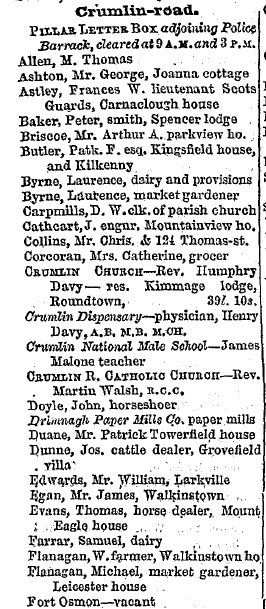
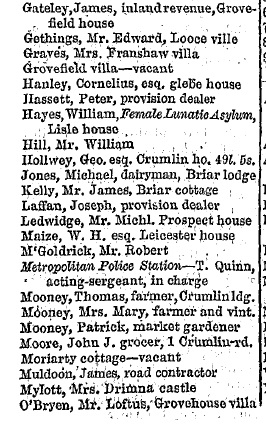
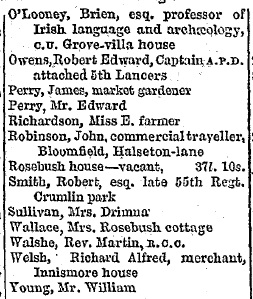
Crumlin Road, Crumlin, in
[Thom's, 1884, p.1534].
Christopher Collins
is listed.
He died 1884.
Thomas Collins
died in 1889 at
"Crumlin Cross Roads".
However already in
[Thom's, 1887]
Collins is no longer listed in Crumlin.
No Collins listing on
p.1549 of
[Thom's, 1889].
The Collins house appears to be the
house near the cross-roads that is shown on later maps as "The Cottage".
Can't see any listing for "The Cottage" in
[Thom's] 1887 or 1889.
Can't see any listing for "The Cottage" in
[Thom's, 1905, p.1723].
Peyton Warren is listed at The Cottage, Crumlin road, in
[Thom's]
1909 to 1914.
See entry
in 1911 census.
James Balfe
is listed at The Cottage, Crumlin road, in
[Thom's]
1915 to at least 1947.
His dau Ellen Balfe
is listed at The Cottage, Crumlin,
when she married James O'Donoghue in
1917.
[Watchorn, 1985, p.91]
drew a map to show Crumlin around 1917.
Balfe's house is shown, but the position is slightly wrong.
"Crumlin Common" is shown to the N, on the former Collins land, but that is wrong.
Taylor's map of 1816 shows Crumlin Common was a bit to the SW.
The map was re-drawn for
[Watchorn, 2024 edn, p.133].
See extract
and full size.
Again the position of Balfe's is slightly wrong,
and the position of Crumlin Common is more wrong.
James Balfe, age 73, died in 1934 at The Cottage, Crumlin Road.
See death cert
from here.
His widow Ellen Balfe, age 65, died in 1937 at The Cottage, Crumlin.
See death cert
from here.
Balfe continues to be listed in
[Thom's]
at The Cottage. Must be the next generation.


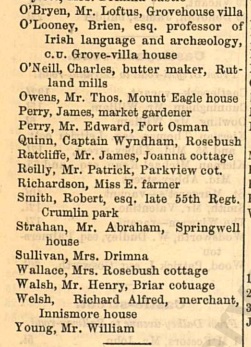
Crumlin Road, Crumlin, in
[Thom's, 1887].
From
p.1542
and
p.1543.
No Collins
is listed.
It is unclear if the Collins house is listed here.

On the
1887 to 1913 map
the Collins farm still exists, as does the house near the cross-roads.
The house near the cross-roads is definitely the house shown on later maps as "The Cottage".

Peyton Warren listed at The Cottage, Crumlin road, Crumlin, in
[Thom's, 1910, p.1737].

A meeting of the South County Dublin Harriers
in 1936 at "Crumlin Cross".
This is probably the Balfe house.
And probably the old Collins house.
Unknown newspaper.
See full size.
Posted here
at History of Walkinstown and Drimnagh/Dublin 12.

"The Cottage", Crumlin, on OS map of 1937 or 1938.
Shows it is the same house as above.
See full size.
- A similar map is shown on pp.84-85 of
[Watchorn, 1985].
Shows that house as "The Cottage".
Watchorn says the map is c.1937.

Crumlin Cross. From the main road, looking SE at Prospect House (demolished 1950s).
Photo seems before the re-development of the location, probably before the 1940s.
To the far right is the boundary wall for the plot beyond the Collins farm.
See
full size.
From
Crumlin & Walkinstown History Group.
Also in
[Watchorn, 2024, p.40]
"James Balfe"
is listed at The Cottage, Crumlin road, in
[Thom's, 1945, p.1298].
This would be a later generation than the original James Balfe who died in 1934.
"James Balfe"
is listed at The Cottage, Crumlin road, in
[Thom's, 1947].
No listing for "The Cottage" or Balfe on Crumlin road in
[Thom's, 1951, p.1325].
The entire site was cleared for housing in 1940s-1950s.
The house is gone.
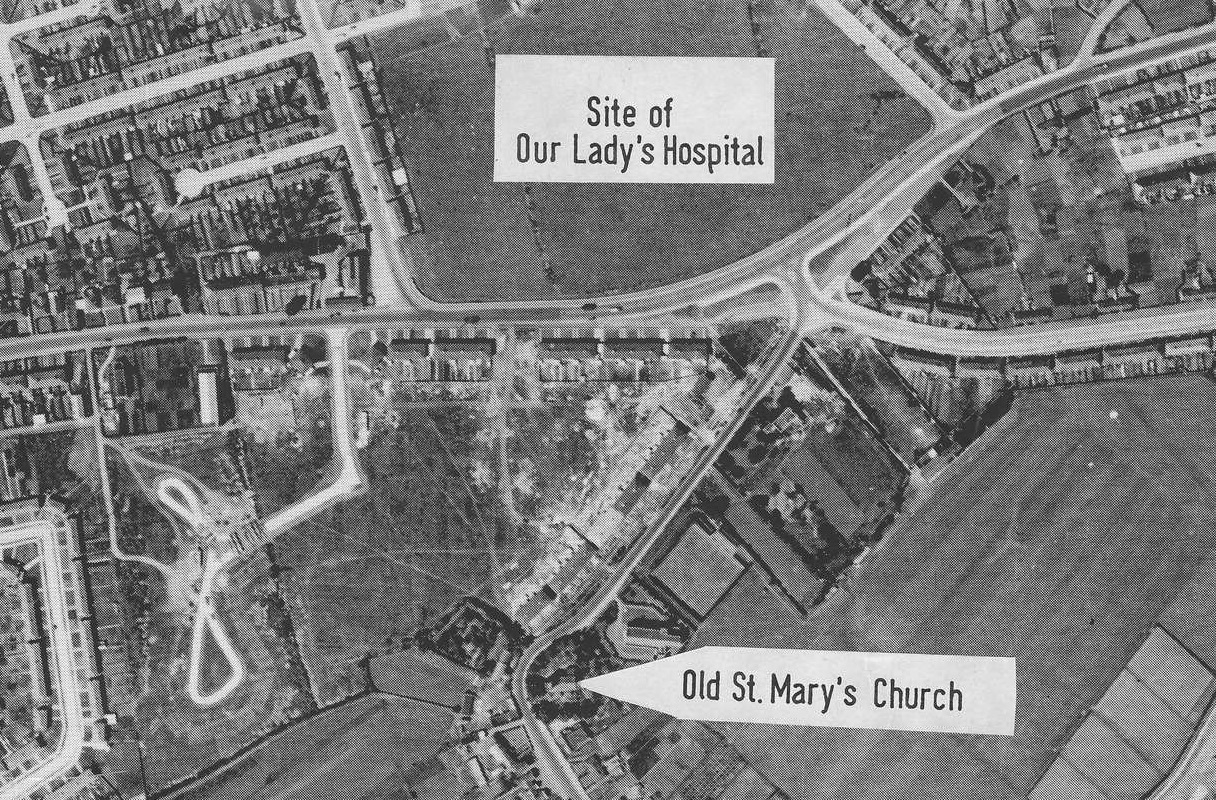
Aerial photo of Crumlin, 1940s.
Children's Hospital not yet started. Photo is before 1949.
New housing is being built on the Collins farm.
Looks like a remnant of the
Collins buildings still exists.
From p.33 of
Crumlin Heritage Audit Report.
See
full size.
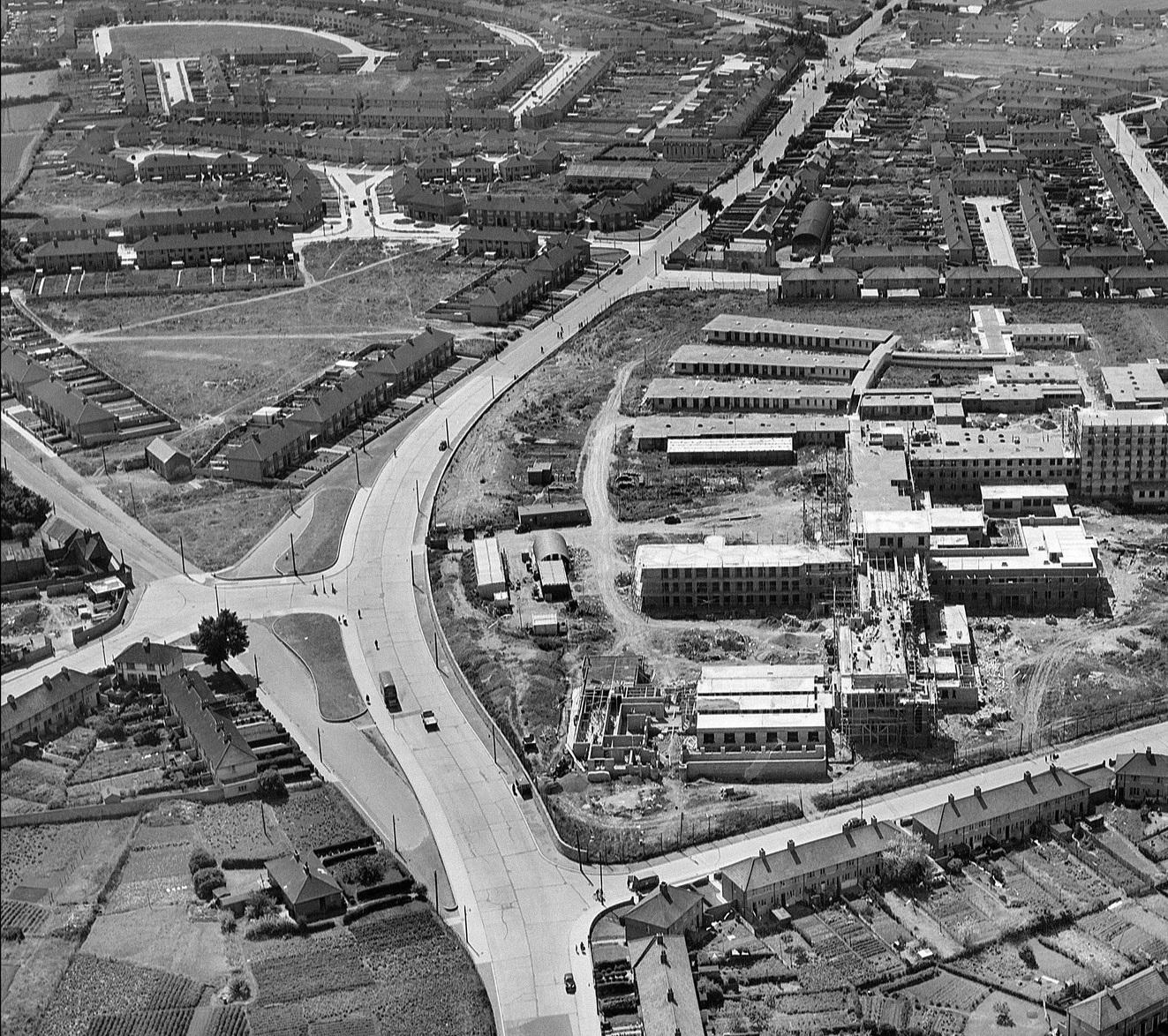
Aerial photo of Crumlin, 1952.
View from NE.
During the period when the Children's Hospital was being built (1949-1956).
New housing is being built on the Collins farm.
Looks like a remnant of the
Collins buildings still exists.
From
The Old Drone: Norman Ashe Aerial Photographic Collection.
Norman Ashe photos are 1952-1954.
See full size.

Close-up of the possible remnant of the
Collins buildings.

Aerial photo of Crumlin, 1952.
View from S.
From
The Old Drone: Norman Ashe Aerial Photographic Collection.
See full size.
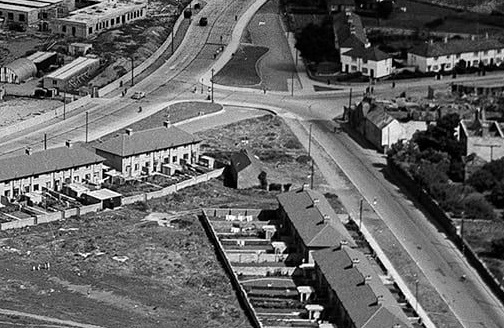
Close-up of the possible remnant of the
Collins buildings.
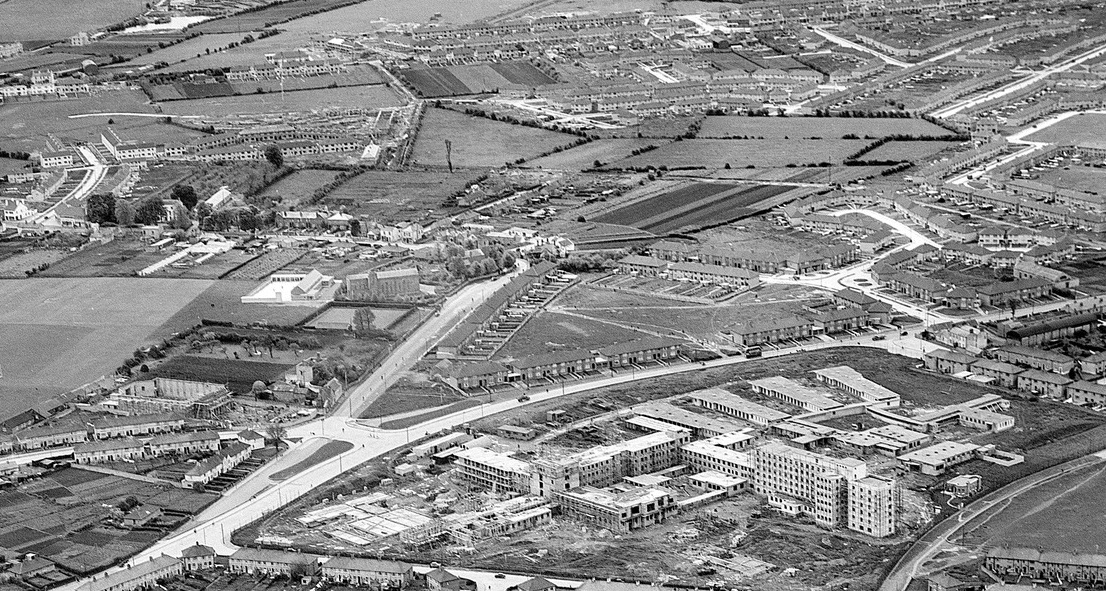
Aerial photo of Crumlin, 1952.
Photo looks
down St.Mary's Road into Crumlin.
Collins farm would be on RHS.
From
The Old Drone: Norman Ashe Aerial Photographic Collection.
See full size.

On the
modern map
the area is completely cleared for a housing estate.
The house is gone.
Just nothing left today.
The apparent location of the Collins house
would be at the end of the row of houses / start of the row of shops, near the cross-roads.

3D view
of the location today.
The new
"Crumlin Cross" is in the small green at the junction.
From Google Maps.
See
street view.

St.Mary's Road, looking towards Crumlin Road. Note the new "Crumlin Cross".
The apparent location of the Collins house would be the row of shops and houses to the left here.
Photo 2012.
See full size.
See other photo.
See view looking
left into Crumlin
(this would be Collins land).
Sources yet to be consulted
- Collins deeds search in
[LR].
- Estate papers of Collins landlords.
There are multiple landlords.
- Purcell papers in [NLI].
- Case between Mrs. Elizabeth Purcell and her son Francis Purcell, Crumlin, a family dispute concerning property.
Date 1768.
P 32.
- Lease, Francis Purcell to John Harvey, of lands in Crumlin, with a map.
Date 1772.
MS Joly 51 (iii).
- A map of part of James Donough's Land near Crumlin held under the late Francis Purcell, Surveyed by John Longfield, 1816.
MS 21 F. 53 / (099)
in
Longfield Map Collection.
- Shaw papers in
[NLI].
- Letter and memoranda book of Sir Frederick Shaw in respect of property at Kimmage and Crumlin,
1846-1859.
Ms 5656.
- Shaw family of Bushy Park, Terenure, Dublin.
Income Ledger, including rents, 1863-76. Payments ledger, 1863-9, Rent ledger, 1863-76. Terenure rent ledger, 1869-76.
Mss. 9456-9459.
Things to do
- The Balfe family might have photos of The Cottage in the 1940s before it was demolished.






































